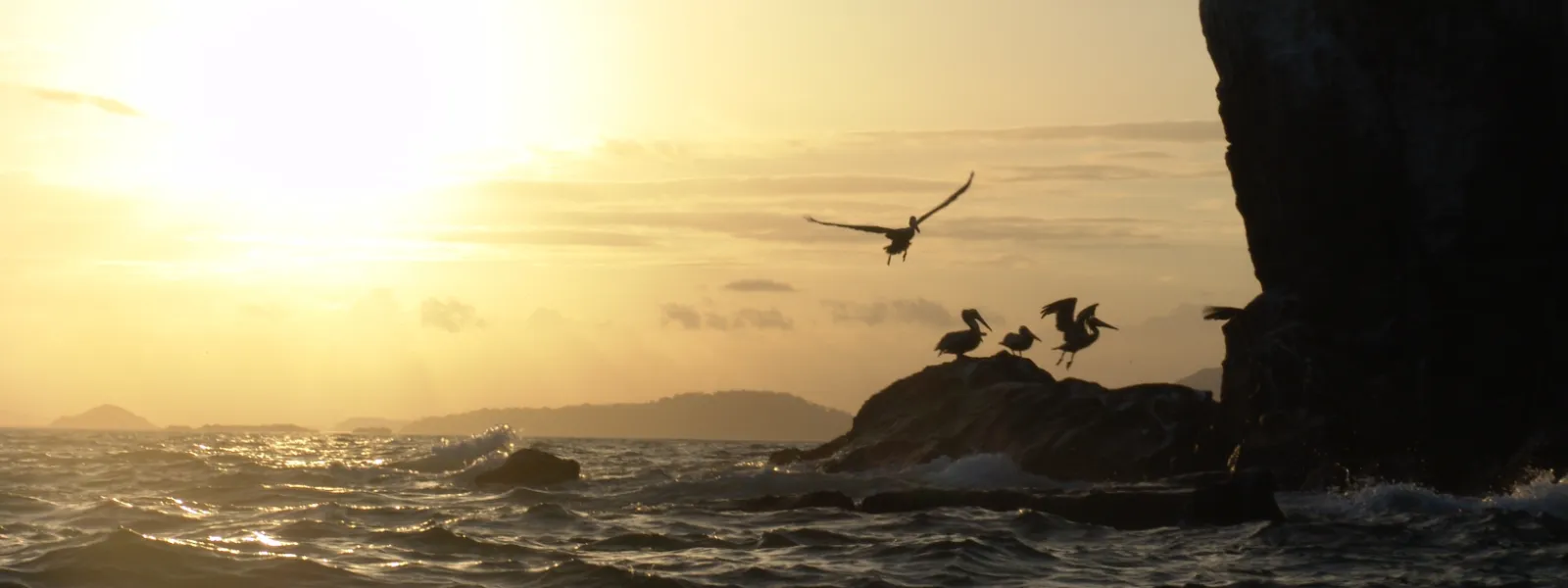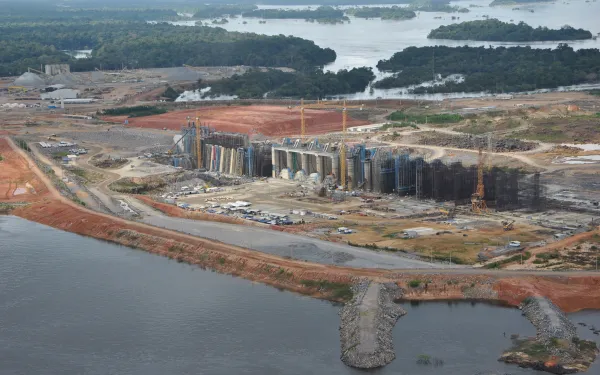
Project
Photo: Alejandro Balaguer / Fundación Albatros MediaVictory: Panama Bay is Legally Protected
Panama Bay, one of the world’s most important nesting and roosting sites for migratory birds, is now permanently protected, thanks in part to AIDA’s expertise in international law.
The bay supports endangered species, including jaguars and loggerhead turtles, as well as the vast majority of the country’s fishing industry. Its coastal mangroves capture 50 times more carbon pollution than a tropical forest of similar size. Mangroves also protect coastal communities from storm surges that grow in severity as the climate warms. Panama has already lost 75 percent of its mangroves.
In 2012 tourism developers had secured a Supreme Court decision overturning the National Environmental Authority’s decision to protect the bay as a wildlife refuge.
AIDA worked with the Environmental Advocacy Center (CIAM), a Panamanian environmental law organization, to defend Panama Bay’s protected status. We submitted a brief containing arguments based on international law. We made analogies between Panama Bay and Las Baulas National Marine Park in Costa Rica. In a legal case about Las Baulas, a balancing test found that the public right to a healthy environment outweighed the interests of tourism developers.
Then, on February 2, 2015—World Wetlands Day—Panama passed a law creating Panama Bay Wetland Wildlife Refuge. The law emphasizes the importance of an ecosystem approach to management and the rational use of wetlands, as described in the Ramsar Convention.
AIDA and CIAM will continue working to see that the law is implemented properly and to ensure the protection of Panama Bay wetlands.
Related projects

Large dams in the Americas: Is the cure worse than the disease?
Large dams consistently cause severe, and often irreversible, environmental and social damage. Their construction is also often associated with violations of international human rights and environmental laws. AIDA’s report Large Dams in the Americas: Is the Cure Worse than the Disease? explores these grave impacts and explains the existing international standards that should be applied to protect the environment and human rights. The report also exposes the dangers of using large hydroelectric dams to meet increasing energy demands in Latin America. To promote greater protection of human rights, AIDA gave testimony based on this dams report to the Inter-American Commission on Human Rights (IACHR) at a general hearing on November 2, 2009. AIDA has also shared the report’s findings with international experts, policymakers, non-governmental organizations, affected local communities, and international financial institutions such as the World Bank and the Inter-American Development Bank. Furthermore, AIDA staff presented legal strategy workshops at "Rivers for Life 3", an international meeting of dam-affected communities in Temacapulín, Mexico, October 1-7, 2010. The previous month, AIDA staff represented Latin America on a panel of water experts at World Water Week in Stockholm. In Large Dams in the Americas, AIDA examines five large hydroelectric dams in violation of a range of environmental and human rights laws: Yacyretá in Argentina and Paraguay, Río Madeira in Bolivia and Brazil, Baba in Ecuador, Chan-75 in Panama, and La Parota in Mexico. Through these case studies, AIDA illustrates how governments generally disregard important international obligations and standards, such as the need to conduct proper environmental and social impact assessments. In the report, we also explain the significant social and environmental impacts caused by large dams. We discuss how families suffer when they are displaced or forcefully evicted by dams and lose valuable farmland, water sources, or traditional fishing areas. We document how the people most harmed by large dams are those from vulnerable populations, including indigenous, afro-descendent and poor farming communities. We also describe how large dams typically harm the environment by flooding valuable ecosystems, dramatically altering natural flows of water, disrupting wildlife habitat, and obstructing the migratory paths of perse species, among other impacts. In addition, Large Dams in the Americas dispels the myth that dams are a source of "green energy". Even though dams do not rely on fossil fuels to generate electricity, they still contribute to greenhouse gas emissions. Hydroelectric dams create enormous reservoirs of river water that submerge valleys and lead to the decomposition of vast amounts of organic matter. As the trees and other biomasses break down, they release carbon dioxide and methane, the same greenhouse gases that are created by "dirty" technologies like coal-fired electricity plants. Turbines also liberate methane trapped in deep water and emit carbon dioxide as they release pressure from the reservoir. In tropical regions, dams can emit as much as eleven times the amount of greenhouse gases that a conventional power plant of equivalent size would emit. Given the negative impacts of large dams, AIDA's report recommends that policymakers seriously consider alternatives that protect human rights and our natural ecosystems, save energy, and reduce greenhouse gas emissions. Suggested alternatives include: improving energy efficiency, reducing demand, making better use of sustainable energy sources, investing in energy-efficient technologies and infrastructure, and removing barriers that hinder technology exchange between nations. AIDA wrote this report in collaboration with our participating organizations, CEMDA, CEDHA, ECOLEX and Earthjustice, as well as International Rivers, Sobrevivencia, and the Association for Conservation and Development (ACD). By educating governments, policymakers, communities, and other key players about large dams, we seek to encourage authorities to investigate the matter and apply our recommendations on how to implement dam projects in compliance with international laws. Spanish-Language Report Available Here
Read more
AIDA calls on financial institutions to join the fight against climate change
International Financial Institutions (IFIs) have a significant influence on large infrastructure projects and energy development in the western hemisphere. Many of them finance projects that accelerate climate change. These include large dams that emit methane gas, mines that disturb carbon sinks, and power plants that inefficiently use highly polluting coal- and oil-based technologies. This financing, for example, is behind “La Colosa,” a huge gold mining project in Colombia. The project could affect the paramos and release the huge amounts of carbon dioxide retained by these high-altitude wetlands. The Inter-American Development Bank (IDB), the World Bank Group (WBG) and its member institution, the International Finance Corporation (IFC), recently carried out research to redesign their energy investment strategies. AIDA took part in this process, pressing the IFIs to prioritize the development of clean and sustainable energy sources. We urged them to: Consider climate change and human rights in every stage of the process; Incorporate the highest standards of human rights, social equity, energy efficiency and natural resource planning in decisions; Set aggressive but achievable targets for reducing carbon dioxide emissions for the projects they support; and Prioritize energy efficiency and renewable energies while also discouraging a continued dependence on fossil fuels. AIDA also participated in the public consultation at which the IDB was called on to give comments on the current policy of the Independent Consultation and Investigation Mechanism (ICIM). While not perfect, the ICIM is the only grievance system available to people affected by activities funded by the institution. AIDA, together with other organizations in the region, sent a letter with the comments, which was a great opportunity to increase the transparency, accountability and effectiveness of the mechanism. Along with the IDB and the institutions of the World Bank Group, there is the National Development Bank of Brazil (BNDES), which, although not officially an IFI, behaves as such and wields a huge influence in the region. It has amassed such financial power to allow it expand outside its borders and participate in large investment projects in more than 11 countries in Latin America. The concern is that BNDES doesn’t have socio-environmental safeguards or transparency and participation policies in line with its size and influence. Instead, it is governed by much lower standards than the IFIs working in the region. BNDES doesn’t have mechanisms to ensure the protection of the environment and communities affected by the projects it finances, nor does it have an effective system for addressing complaints or claims. In fact, the projects supported by BNDES have been drawing attention from environmentalists and human rights defenders in the region for years. We have focused much of our work on influencing this organization so it will promptly implement appropriate environmental and social policies. What is interesting and encouraging is that we’re not alone in this task. In November 2012, we created a coalition called “BNDES na Mira,” which brings together over 90 people from more than 25 organizations in the region. The group is a reflection of the need to work together to achieve ambitious and needed results. At the same time and as part of the ongoing training of our team and the group in general, we are developing a report to explain the inner workings of BNDES so that we can understand their decision-making process and pressure points. We also hope to make contacts to help us have an impact in and outside the bank. To address BNDES’ lack of recognition as an IFI and hence its need to comply with the responsibilities that entails, AIDA is working on a third document that will develop this argument and provide a comparison between the safeguard and transparency policies of BNDES and other IFIs working in the region such as the World Bank and the IDB. Also as part of “BNDES na Mira,” we participate in workshops and seminars to further strengthen our joint work, share information and develop common strategies for the future and a possible long-term channel of communication with representatives of the bank. Given the huge amounts of money that IFIs and BNDES provide to projects and programs around the continent, any influence that we can have on their policymaking can lead to significant reductions in the emissions that cause climate change. These institutions have the opportunity to choose new tools to redirect their path toward truly sustainable development, and therefore to help protect our health and the environment from climate change. AIDA will continue examining and influencing the IFIs and BNDES on a constant basis and especially during their process of reshaping internal policies.
Read moreCEMDA and AIDA Present Report to Inter-American Court of Human Rights: Environmental Advocates Are Key to Protecting Human Rights and Are At-Risk in Mexico
FOR IMMEDIATE RELEASE: Sept. 15, 2010 CONTACTS: Juan Carlos Arjona Estévez, CEMDA (Mexico) +52-55-5286-332, [email protected], Skype: juancarlosarjonaestevez Jacob Kopas, AIDA, (Bogota) +57-1-338-1277, [email protected], Skype: jacobkopas Mexico City, Mexico – On September 10, 2010, the Centro Mexicano de Derecho Ambiental (CEMDA) and the Interamerican Association for Environmental Defense (AIDA) presented information about the important work of environmental advocates in protecting human rights, and about the trend of increasing attacks against such advocates in Mexico. In a "friend of the court" brief submitted to the Inter-American Court of Human Rights in the case of Cabrera Garcia and Montiel Flores v. Mexico, the two organizations demonstrated how attacks against Teodoro Cabrera and Montiel Flores relating to their work as environmental advocates impedes effective environmental protection. "In Mexico, it is still very difficult to protect the right to a healthy environment due to the lack of, or in some cases, the ineffectiveness of judicial protections," emphasized Juan Carlos Arjona Estevez, coordinator of CEMDA’s Human Rights and Environment Program. "This makes the pattern of aggressions against environmental advocates even more troubling—it affects the rights of everyone in Mexico." In 1998, Mr. Cabrera and Mr. Montiel founded the Organization of Peasant Ecologists of the Sierra de Petatlán and Coyuca de Catalán (OCESP), to protect the forests in Guerrero state from uncontrolled and illegal timber extraction. A year later, they were victims of arbitrary detentions and torture due to their work as environmental advocates. Despite being released in 2001, they had to leave their community because of continued threats. Nine years after their release, the Inter-American Court heard Montiel and Cabrera’s claims against Mexican authorities for failing to compensate them for harms or to guarantee their personal safety. The ineffectiveness of the legal system for protecting the environment in Mexico led Mr. Cabrera and Mr. Montiel to found their organization, OCESP. However, the threats and harassments they suffered, and the lack of response from authorities, created a generalized fear that prevented them and others from defending their community’s right to a healthy environment. Later, this pattern grew to include attacks against environmental advocates throughout Mexico. This situation forced Mr. Cabrera and Mr. Montiel to limit their work as environmental advocates and curtail the work of OCESP. Jacob Kopas, a lawyer with AIDA considers that "This case is emblematic for the region, and highlights the need for governments to recognize the value and importance of the work done by environmental advocates, and to also guarantee protection for their rights." "With this report, we are seeking to help strengthen protection of the right to a healthy environment in Mexico and safeguard the people who defend this human right" said Samantha Namnum, director of CEMDA’s Mexico City office. "This is why we asked the Inter-American Court to recognize the important work of environmental defenders and to declare that Mexico, in addition to other human rights, also violated Mr. Cabrera and Mr. Montiel’s right to freedom of association as a result of the arbitrary detentions and tortures they suffered and the impunity surrounding those events."
Read more